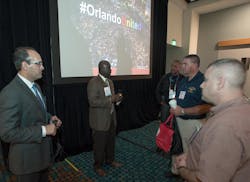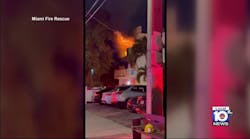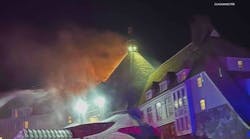The June 12, 2016, Pulse Nightclub shooting in Orlando, FL, was the deadliest mass shooting in United States history, with 49 fatalities and more than 60 others injured. Dozens of first responders descended on the scene, including firefighters from the Orlando Fire Department (OFD) and the Orange County Fire Rescue Department (OCFRD).
During their Firehouse Expo session “Lessons Learned from the Response to the Pulse Nightclub Incident,” OFD Fire Chief Roderick S. Williams and OCFRD Fire Chief Otto Drozd III walked attendees through the response, from the initial chaos to the hours-long coordination of resources, and reflected on key elements of the response and the aftermath.
Prior to Pulse
The chiefs discussed how recommendations for handling active shooter events (ASEs) have evolved since the 1999 Columbine shooting, which was referred to as the “foundational event.” Police would go in first, clear the scene, and then fire/EMS personnel would go in later. Unfortunately, this approach led to many deaths at Columbine, as victims bled out while waiting for medical attention, they explained. Fast-forward to the 2012 Aurora movie theater shooting, which resulted in similar problems with victim assistance, and where there was no unified command and a disjointed triage, they said, and it was clear that there needed to be a different approach to these incidents. This is when the first iterations of what we now know as Rescue Task Forces (RTF) started to take hold.
Both OFD and OCFRD had experience with an ASE prior to the Pulse shooting. In 2009, the OFD responded to an incident where a disgruntled employee shot and killed one and wounded five others. For OCFRD, in 2013, there was an incident at the University of Central Florida that was ultimately a “near miss” ASE. The shooter, who was about to initiate a coordinated attack on a large group of students, was spotted by another student, retreated and shot himself before he could carry out his plan. “It could have been a huge tragedy,” Drozd said.
Fortunately, the departments had engaged in extensive training to learn how to mitigate incidents of this nature. Going back as far as 2005 and up to as recently as 2015, the departments had engaged in mass-casualty incident (MCIs) training, active shooter drills at area high schools, a Joint Counterterrorism Awareness Workshop and EOD exercises, many of which were held in conjunction with police, FBI or other agencies to maximize coordination of efforts.
Considering the training and planning that had occurred, Roderick noted that they felt that they had “checked every box,” which did pay dividends the night of the Pulse incident, but that it was certainly not as perfect as they had practiced in the field.
Chaos Ensues
At approximately 2 a.m., the shooter began firing on club patrons. Within minutes, the incident transitioned from an ASE to a hostage situation to an MCI. Amidst the chaos, the first actions focused on establishing command, staging and triage areas, and implementing MCI procedures.
OFD Station 5 is located just one block from Pulse, so firefighters were on scene immediately. Additionally, the Orlando Regional Medical Center—a trauma center—is located two blocks from the scene. While the hospital’s proximity was of course helpful, it also meant that victims who were wounded but able to escape the club began self-transporting to the hospital. Roderick explained that in a chaotic situation, people do not always go where the firefighters are. “People were going past triage,” which was initially located right across the street from the club, he said. He added that many police officers were transporting victims in their cars, instead of taking them to triage. Although this made it difficult to get an accurate assessment of the victims, their swift action to take victims to the hospital, which was so close, likely saved many lives.
OCFRD units were dispatched a bit later and on scene in approximately 25 minutes. These crews dealt with patient care, transport, responder rehab and MCI unit equipment. An assistant chief was at the OFD command posts, and a battalion chief was assigned as the initial staging officer. There was ballistic gear on the three captains’ units as well.
Just before 3 a.m., there were still 12–15 patients in the club who were in need of help. SWAT procedures were being initiated. OPD decided to move its command location, while OFD stayed at its original location, creating a communication disconnect.
Communications Breakdown
Around 3:40, there were reports of a possible explosive device. The safe zone was moved back, and staging relocated. Explosive Ordinance Disposal (EOD) response was initiated at 4:06 a.m.
Just after 5 a.m., SWAT officers breached a wall and engaged in gunfire with the shooter. He was eventually killed, and the remaining hostages were freed. One of the key issues with this part of the incident, the chiefs explained, was the breakdown in communication related to the wall breach. Specifically, the fire personnel were unaware that a breach was about to occur. “The explosion was the clue that the breach was happening,” Drozd said, adding that this action created TWO chaotic scenes, as fire personnel thought a secondary incident had occurred.
Getting Coordinated
Fortunately, the responders were able to better coordinate their efforts later in the incident, a difficult feat considering the number of agencies involved—police, SWAT, fire, arson, EMS, hospitals, highway patrol, FBI, ATF, drug enforcement, DHS, etc. “Once we got on the same page, it was one of the best shows of unified command,” Roderick said. “I saw no egos.” Both chiefs praised the efforts of first responders for adapting to the constantly changing scene into which they were thrust, particularly as no firefighters or police officers were injured or killed in the highly dangerous operation.
One of the best displays of coordinated action was the prompt activation of the emergency operations center (EOC), which was active around the clock for 10 days, starting the morning of the incident. EOC services worked with the Red Cross and similar agencies to provide much-needed support and resources to family and friends of the victims. “This went on for weeks,” Roderick said. Drozd added, “These are the considerations we all have to think about when you have a mass shooting—what are the aftereffects of what you have to take care of? It’s interagency coordination at its height.”
One of the most difficult aspects of the post-incident activities was victim removal, which was coordinated by the Orange County Medical Examiner’s Office. Drozd explained that his department was asked to assemble a team to help. Several firefighters, many of whom had responded to the incident, volunteered to help. They ultimately did not have to do so, but “I am proud that we have this kind of people in the service,” Drozd said. (A hazmat team, with a representative from the ME’s office, removed all the deceased victims from Pulse.)
Drozd also shared a great example of public-private partnership emerged from the tragedy. A family assistance center was needed, so Disney stepped in by taking an abandoned county building and transforming it into a professional space that looked like new construction.
Support & Help
Numerous dignitaries—President Obama, Hillary Clinton, FBI Director James Comey, Attorney General Loretta Lynch, governors, mayors, members of Congress and many more—offered their support and assistance following the shooting. Many were even meeting with the first responders, which presented yet another level of coordination and planning.
Drozd shared that there was a sense that the police were getting quite a bit of attention in the media for their efforts, even meeting with the president when he visited. As such, he decided to write a letter to the local paper, thanking all the public safety personnel for their efforts and remarking specifically on the great work of the firefighters.
But Drozd’s bigger concern was caring for the firefighters’ mental health. “All of these responders on scene, seeing a once-in-a-lifetime event, we had to take care of our own,” he said. The morning after the shooting, crews were required to come in for an incident debriefing. And the day after that, responders were invited to meet with responders from similar incidents who could provide advice and support. CISM teams and peer-support teams were activated, comfort dogs were brought in, family counseling was provided, and outreach was offered from community members and faith-based organizations. Even the business on the same block as Pulse that had been temporarily shut down due to the ongoing investigation did everything they could to help, including cooking meals for command post staff. “There was no lack of participation,” Drozd said, adding that donations poured into to help victims and families.
Lessons Learned
The chiefs detailed a variety of lessons learned from the incident, spanning a range of topics.
Communications
Due to issues with antiquated equipment, agencies working on different radio channels and some chief officers arriving “late in the game,” Roderick said, a new alert process for earlier notification to OFD chief command staff was implemented. This alert process includes a follow-up phone call if the member has not responded to the initial alert within 3 minutes.
As noted, indirect communication with the OPD and command post hampered communication prior to wall breach, so fire crews did not know what was about to happen, creating additional confusion. “There was no reason to have two chaotic scenes,” Drozd said, adding that it’s important to establish a communications plan with the appropriate number of tactical channels.
In terms of getting communications to the public, Roderick said, there should always be a quick establishment of a Hotline to help the hospitals and communications centers that were fielding calls from family and friends.
Hospital Operations
Roderick explained that it is important to collaborate with community partners to identify and establish a system for patient tracking, as well as to establish a family assistance plan for MCIs. Further, there should also be an increased presence for fire and law enforcement liaisons.
Command and Control
Drozd noted that when it comes to unified command, “We owe it to ourselves to put the structure in place,” he said. He added that command officers were getting so many notifications that they have pared it down a bit so that they are only getting notified of the critical incidents—and then there is a follow-up phone call so to ensure the officer gets the alert.
EMS Operations
Drozd indicated that the transportation group leader must be able to track the number of patients being transported, have accurate hospital counts and know the status of each patient.
Equipment
In terms of the ballistic gear, “We had the equipment on scene and it was not deployed,” Drozd said. “This won’t happen to us again in the future.” He added that it’s important to ensure the appropriate number of ballistic vests, helmets and medical care packs. Further, he underscored that the IAFC and IAFF recommend the use of ballistic vests and helmets on scene for RTF teams. Roderick added that the fire service is responding to an increasing number of violent situations—but the right equipment must be used and in a timely manner. “Once we’re in staging, why not put a vest on?” he asked.
Going Forward
The chiefs indicated that they will take the experiences and lessons from the Pulse incident and use them to guide future training exercises and joint drills to improve communication and coordination of efforts.






